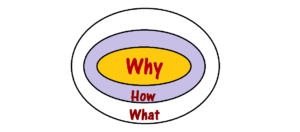 Focus on the ‘why’ keeps us aligned to our vision, our purpose, writes SSAT senior education lead Dan Belcher.
Focus on the ‘why’ keeps us aligned to our vision, our purpose, writes SSAT senior education lead Dan Belcher.
One of the most viewed TED talks is Simon Sinek’s ‘Start with why’. At the time of writing it has had over 33 million views. Sinek’s key point is that as individuals and organisations we need to ‘find our why’. The why is not to achieve profits or examination results – it’s your cause, your purpose, why your organisation exists and why you get out of bed in the morning. It is this, he argues, that lies behind why some leaders and some organisations are more inspiring, inventive and successful than others.
This is encapsulated in ‘the golden circle’. It works from the inside out rather than the outside in. It starts not with the what (the product, service) but with the why. And it is grounded in our biology. It appeals to our limbic brain, the part that is considered to be largely responsible for human behaviour and decision making, but with no capacity for language. It is where feelings of trust and loyalty are found. People don’t buy what you do, they buy why you do it.
 Sinek puts it this way: ‘For great leaders the golden circle is in balance. They are in pursuit of WHY, they hold themselves accountable to HOW they do it and WHAT they do serves as tangible proof of what they believe’ (Sinek, 2009)
Sinek puts it this way: ‘For great leaders the golden circle is in balance. They are in pursuit of WHY, they hold themselves accountable to HOW they do it and WHAT they do serves as tangible proof of what they believe’ (Sinek, 2009)
A few weeks ago I met a friend who recently started his own law firm, in part because he wanted to re-find his why. His reading of Sinek’s book was affecting the kind of culture he wanted to establish in his small but growing team. A culture that wasn’t driven by billable hours but by doing what’s right to help the client. He’d had his ‘Jerry Maguire’ moment, as we call it.
The why is a strong motivator
We all want to buy into something bigger than ourselves that gives our lives a sense of purpose and meaning. For teachers and school leaders it is important we know our personal and collective why, the moral purpose of what we do, what brought us into the profession and what kind of education we want for our children. Keeping focused on the why keeps us aligned to our vision, our purpose. It also keeps us and those who work alongside us passionate and motivated. It’s easy to be distracted by policy, by circumstances and accountability pressures. Expediency and pragmatism quickly creep in and cause our actions to become out of line with our vision. Focusing on the why is the best way to sustainable success.
England rugby player Maggie Alphonsi MBE believes understanding the why of each member of the team was crucial to England winning the 2014 Women’s Rugby World Cup, and subsequently being crowned BBC Sports Personality Team of the year, as she explained to participants in this video clip from SSAT’s High Performance Leadership programme.
For the school leaders I speak to there is often a strong why that motivates their actions. For example: Paul was brought up in a poor working class family in a multi-cultural community, in which racism was normalised. He received free school meals and had to stand at the back of the dinner line. In school he was separated from the friends he would socialise with outside. He understood that there was something inherently wrong with his experiences of social injustice and conceptions of poverty. At university, he learned to understand and challenge it, making the decision to become a teacher. Now, as a headteacher, he leads a school that doesn’t segregate or separate children by background or ability. His moral purpose is to remove barriers of access, opportunity and outcome for all children and their families.
Some questions to consider:
• When was the last time you reflected on your personal why?
• Do you know the whys of your colleagues and teams? How might this be helpful?
• What is your school’s vision or mission statement?
• Whose vision is it? Is it shared by all?
• Does the why (vision, values, mission) permeate all that takes place in the school?
• If so, how? Is there alignment or tension?
